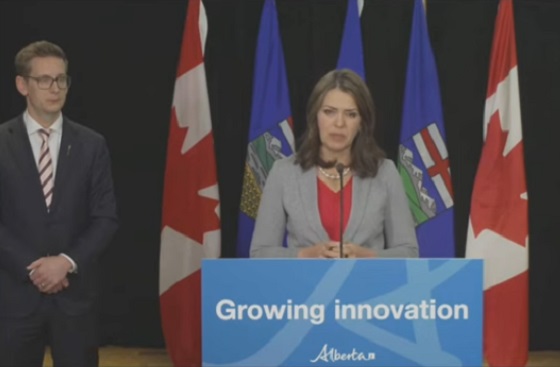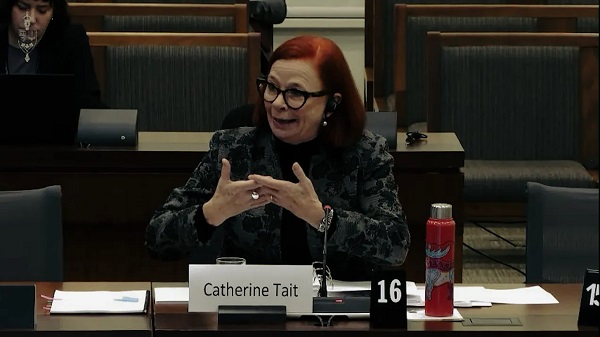Alberta
Parents in every province—not just Alberta—deserve as much school choice as possible

From the Fraser Institute
Not only does Alberta have a fully funded separate (Catholic) school system, it also provides between 60 and 70 per cent operational funding to accredited independent schools. In addition, Alberta is the only province in Canada to allow fully funded charter schools. And Alberta subsidizes homeschooling parents.
This week, the Smith government in Alberta will likely pass Bill 27, which requires schools to get signed permission from parents or guardians prior to any lessons on human sexuality, gender identity or sexual orientation.
It’s a sensible move. The government is proactively ensuring that students are in these classes because their parents want them there. Given the sensitive nature of these topics, for everyone’s sake it makes sense to ensure parental buy-in at the outset.
Unfortunately, many school trustees don’t agree. A recent resolution passed by the Alberta School Boards Association (ASBA) calls on the Smith government to maintain the status quo where parents are assumed to have opted in to these lessons unless they contact the school and opt their children out. Apparently, the ASBA thinks parents can’t be trusted to make the right decisions for their children on this issue.
This ASBA resolution is, in fact, a good example of the reflexive opposition by government school trustees to parental rights. They don’t want parents to take control of their children’s education, especially in sensitive areas. Fortunately, the Alberta government rebuffed ASBA’s demands and this attempt to abolish Bill 27 will likely fall on deaf ears.
However, there’s an even better safeguard available to Alberta parents—school choice. Out of all Canadian provinces, Alberta offers the most school choice. Not only does Alberta have a fully funded separate (Catholic) school system, it also provides between 60 and 70 per cent operational funding to accredited independent schools. In addition, Alberta is the only province in Canada to allow fully funded charter schools. And Alberta subsidizes homeschooling parents. Simply put, parents who are dissatisfied with the government school system have plenty of options—more than parents in any other province. This means Alberta parents can vote with their feet.
Things are quite different in other parts of the country. For example, Ontario and the four Atlantic provinces do not allow any provincial funding to follow students to independent schools. In other words, parents in these provinces who choose an independent school must pay the full cost themselves—while still paying taxes that fund government schools. And no province other than Alberta allows charter schools.
This is why it’s important to give parents as much school choice as possible. Given the tendency of government school boards to remove choices from parents, it’s important that all parents, including those with limited means, have other options available for their children.
Imagine if the owners of a large grocery store tried to impose their dietary preferences by removing all meat products and telling customers that the only way they could purchase meat is to make a special order. What would happen in that scenario? It depends on what other options are available. If this was the only grocery store in the community, customers would have no choice but to comply. However, if there were other stores, customers could simply shop elsewhere. Choice empowers people and limits the ability of one company to limit the choices of people who live in the community.
Think of government school boards as a monopolistic service provider like a grocery store. They often do everything possible to prevent parents from going anywhere else for their children’s education. Trusting them to do what’s best for parents and children is like assuming that the owners of a grocery store would always put the interests of their customers first and not their own self-interest. Monopolies are bad in the private sector and they’re bad in the education sector, too.
Clearly, it makes sense to require schools to get proactive consent from parents. This ensures maximum buy-in from parents for whatever courses their children take. It’s also important that Alberta remains a bastion of school choice. By making it easier for parents to choose from a variety of education options, Alberta puts power in the hands of parents, exactly where it belongs. Parents in other provinces should want that same power, too.
Alberta
Alberta laying out the welcome mat for AI Data Centres

Fueling innovation through AI data centre attraction
Alberta’s government is aiming for Alberta to become North America’s destination of choice for Artificial Intelligence (AI) data centre investment.
The AI data centre attraction strategy identifies three pillars that create the foundation of Alberta’s work to position itself as a competitive player in the global AI landscape: power capacity, sustainable cooling and economic diversification. In each of these strategic areas, there are policy and regulatory levers required in addition to other steps Alberta’s government is taking to ensure Alberta is the most attractive and competitive destination for this emerging sector. The entire approach prioritizes competitive advantages, economic integration, market stability and keeping utilities reliable and affordable.
“Artificial intelligence is behind all the newest technologies we rely on to make our lives better, simpler, safer. There’s incredible opportunity around artificial intelligence and we are unafraid to dream big. This strategy will position Alberta as the place to invest and build AI data centres, further building on our reputation as a province with no limit to innovation and opportunity.”
The world’s largest AI companies are in search of opportunities to build and energize their data centres. Alberta, with its abundant natural gas supply and world-class power industry, is highly attractive to AI data centre projects. The province’s unique competitive power market opens the door to many opportunities for AI companies to partner with Alberta’s talented and experienced electricity sector. The sector has decades of experience in finding innovative solutions to meet industry’s power needs while maintaining a balance of affordability and reliability in a system that Albertans count on.
AI data centres generate a lot of heat and require cooling. The strategy encourages operators to determine the cooling technology best suited for their needs, water license availability and regional and project circumstance. Additionally, Alberta’s climate offers significant advantages for AI data centres because of the province’s cold winters, which would reduce the need for artificial cooling systems.
Alberta’s government seeks to ensure Albertans benefit from AI data centres and is committed to ensuring economic growth and shared prosperity while ensuring Alberta continues to have the lowest taxes in Canada and is competitive across North America.
“Alberta is uniquely positioned to capture the AI data center opportunity, leveraging our vast natural gas resources and pro-business environment to create thousands of high-quality jobs and attract billions in investment. This strategy is not just about building infrastructure; it’s about fostering innovation and establishing Alberta as a hub for high-tech industries, driving economic growth and supporting critical public services like healthcare and education.”
Alberta is committed to fostering innovation and ensuring technology development aligns with industry needs. The strategy was developed after extensive consultation with organizations and businesses in the AI space and market participants.
“For AI companies to build and scale in Alberta, they need access to computing power. Data centers are economic growth engines that provide the computing power AI companies need to develop and deploy their innovations. grow their companies and stimulate the local economies. Beyond its natural advantages, Alberta boasts a robust AI ecosystem anchored by world-class research and talent. Many of the algorithms the world’s data centers are running on have been pioneered by Amii researchers right here in Alberta. The opportunity for those companies to be close to the source of some of the leading AI research gives them a competitive advantage in being at the forefront of what is coming next.”
Quick facts
- Over the past several months, Technology and Innovation met with AI data centre builders and operators, power generators, natural resource sector participants, telecommunications companies and municipalities actively pursuing AI data centres.
- AI data centre market size is anticipated to more than double by 2030 to more than $820 billion. (P&S Market Research)
- Alberta Electricity System Operator (AESO) has 12 data centre projects on their project list totalling 6,455 MW of load.
- Most of the power demand on the AESO project list is from data centers.
- Currently there is about 1,000 MW of additional dispatchable generation over Alberta’s current needs. This amount is dynamic and may change due to factors such as generation retirements, outages, derates, or new additions.
Related information
Alberta
Alberta government’s fiscal update underscores need for rainy-day account

From the Fraser Institute
By Tegan Hill
According to the Smith government’s recent fiscal update, the government’s $2.9 billion projected budget surplus has increased to a $4.6 budget surplus in 2024/25 mainly due to higher-than-expected resource revenue. But the resource boom that fuels Alberta’s fiscal fortunes could end at any moment and pile more government debt on the backs of Albertans.
Resource revenue, fuelled by commodity prices (including oil and gas), is inherently volatile. For perspective, in just the last decade, the Alberta government’s annual resource revenue has been as low as $2.8 billion (2015/16) and accounted for just 6.5 per cent of total government revenue. In contrast, according to the Smith government’s fiscal update, projected resource revenue is $20.3 billion this fiscal year and will account for more than a quarter (26.1 per cent) of total government revenue.
But here’s the problem.
Successive Alberta governments—including the Smith government—have included nearly all resource revenue in the budget. In times of relatively high resource revenue, such as we’re currently experiencing, the government typically enjoys surpluses and, flush with cash, increases spending. But when resource revenues decline, the province’s finances turn to deficits.
The last time this happened Alberta ran nearly uninterrupted deficits from 2008/09 to 2020/21 while the province’s net financial position deteriorated by nearly $95 billion. As a result, Albertans went from paying $58 per person on annual provincial government debt interest costs to nearly $600 per person.
So how can the Smith government avoid the same fate as past Alberta governments who wallowed in red ink when the boom-and-bust cycle inevitably turned to bust?
The answer is simple—save during good times to help avoid deficits during bad times. The provincial government should determine a stable amount of resource revenue to be included in the budget annually and deposit any resource revenue above that amount automatically in a rainy-day account to be withdrawn in years when resource revenue falls below that stable amount.
This wouldn’t be Alberta’s first rainy-day account. In fact, the Alberta Sustainability Fund (ASF), established in 2003, was intended to operate this way. A major problem with the ASF, however, was that it was based in statutory law, which meant the Alberta government could unilaterally change the rules governing the fund. Consequently, the stable amount was routinely increased and by 2007 nearly all resource revenue was used for annual spending. The ASF was eventually drained and eliminated entirely in 2013. This time, the government should make the fund’s rules constitutional, which would help ensure it’s sustained over time.
Put simply, funds in a resurrected ASF will provide stability in the future by mitigating the impact of cyclical declines on the budget over the long term.
In the recent fiscal update, the Alberta government continues to risk relying on relatively high resource revenue to balance the budget. To avoid deficits and truly stabilize provincial finances for the future, the Smith government should reintroduce a rainy-day account.
Tegan Hill
Director, Alberta Policy, Fraser Institute
-

 COVID-192 days ago
COVID-192 days agoNew York City workers fired for refusing COVID jab ask Trump, Vance, RFK Jr. to reinstate them
-

 Business2 days ago
Business2 days agoTaxpayer watchdog says Canadian gov’t needs to use Trump ‘blueprint’ and create efficiency agency
-

 Bruce Dowbiggin2 days ago
Bruce Dowbiggin2 days agoMamas, Don’t Let Your Babies Grow Up To Be Running Backs (Pt.2)
-

 illegal immigration1 day ago
illegal immigration1 day agoCourt rules in favor of Texas in razor wire case
-

 COVID-191 day ago
COVID-191 day agoCanadian doctor ordered to pay back $600k she earned through mass COVID vaccination
-

 National1 day ago
National1 day ago2SLGBTQIA+ group bullies small Canadian town for rejecting ‘pride flag’
-

 Environment1 day ago
Environment1 day agoActivist shares how Canadians can fight globalism through local action
-

 Frontier Centre for Public Policy2 days ago
Frontier Centre for Public Policy2 days agoHealth Risks from Water Fluoridation are not just in RFK’s Head








